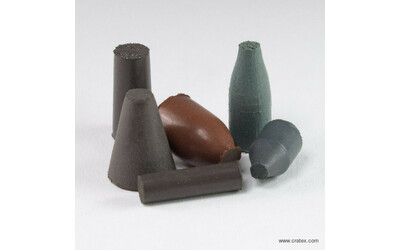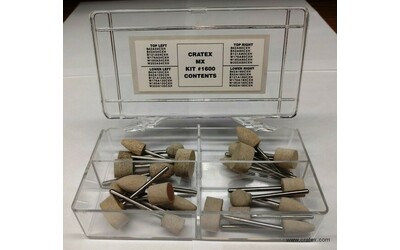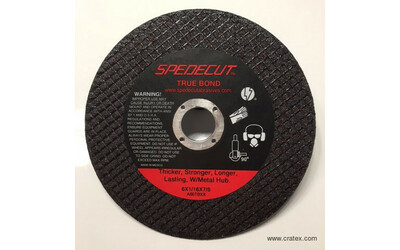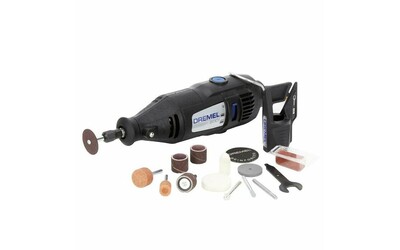
“My Dremel rotary tool has been a faithful helper with a number of tasks around the shop, I am sure that I use this tool every day. Once I discovered the CRATEX rubber-bonded abrasive tools I started to take on more challenging projects.”
Free UPS Ground shipping on all online orders over $149
Did you know that your favorite polishing tools fit your favorite rotary tool perfectly? That’s right! Various CRATEX bits can be mounted on conventional portable motor tools such as Dremel, Foredom and Craftsman and used for a broad range of light grinding, deburring, smoothing and polishing operations.
A great number our loyal, long-term customers simply love their Dremel hand rotary tools, so why not make CRATEX abrasive bits fit their favorite tools?
Unique in its capability, CRATEX abrasives are made of premium quality silicon carbide of highest level of purity, bonded with oil-resistant rubber. Two types of bonds are available: the standard and the hard bond.
Standard rubber bond has a self-cushioning characteristic which allows it to cut freely and to achieve a smooth and mirror-like finish without digging into the workpiece surface. In case you need to smooth and polish metallic or non-metallic surfaces but keep control and avoid losing dimensional tolerances, standard bond is the right choice for you!
In case you need an increased cutting action from your abrasive tool, then hard bond is what you need. It is used for light grinding and light metal removal operations and can be used on hard metals such as stainless steel for removing burrs.
Both standard and hard bond are made in four standard grit textures: coarse, medium, fine and extra fine.

CRATEX Rubber Dremel Bits

MX Abrasives

Spedecut Cut-off Wheels

How to Use a Dremel Tool
CRATEX abrasives that fit Dremel rotary tools are made in different shapes and sizes. Depending on your needs, you can choose between small wheels, points and cones, and with CRATEX online store you can purchase as many pieces as you want!
CRATEX mounted bits have been used by gunsmiths, bladesmiths and knifemakers , jewelers and lapidaries , and dental technicians for many decades. With various professions and applications in mind, we came up with various combo, introductory and test kits, so make sure you check these out as well in case you are not sure where to start.
CRATEX offers two types of wheels for various Dremel polishing and grinding: shaped and straight. Tapered edge wheels are extremely adaptable and therefore suitable for fine, precision work on delicate parts. Usual applications include polishing, cleaning and finishing.
Straight edge wheels can be used for different kinds of deburring, smoothing and polishing operations where complete control of metal removal is crucial. Usual applications include micro-deburring, polishing various surface defects such as scratches and fatigue lines. We recommend small straight-edge wheels for working on dies, molds, electronic parts and sensitive scientific devices, jewelry, instruments, plastic articles, control mechanisms, aerospace components and light castings.
There are three shapes of CRATEX points: cylinder, bulled and tapered. Precisely their shape makes them perfect tools for working on hard-to-reach surfaces and operations such as polishing dies, molds, light castings and patterns, for cleaning contact points and solder spots, damaskeening and micro-deburring.
CRATEX cones are ideal for difficult smoothing, polishing and deburring operations and, like points, for work on hard-to-reach areas. Just some of the applications are on dies, molds and castings, stainless steel tanks, combustion chambers and ports, turbine blades, ball corners, flares, angles and grooves.
What about mandrels, you ask? We got you covered here as well! CRATEX offers high-quality mandrels that were built to last! They come in packs of 10 and are designed to easily attach your rubber-bonded abrasive wheels, points and cones to your Dremel or other rotary tools.
Remember to go through the speed safety recommendations and get your mandrels order on your way today!
Wheels, points and cones come in a wide variety of shapes and sizes, so they’ll be exactly what you need in 99% of the cases. However, we understand that occasionally the need for a special shape can arise, and such shape can easily be achieved by adapting a standard shape.
CRATEX abrasives can be easily shaped to special contours by using different CRATEX conventional abrasive dressing tools – rubber-bonded square or oblong sticks.
Six different rubberized abrasive kits with different small wheels, points, cones and mandrels for Dremel are available at CRATEX online store (Dremel polishing kit, smoothing, sanding, deburring and grinding sets for various rotary tools). In addition, we recommend two separate mini kits with wheels and points for an amazing price with shipping and handling fees included in case you’d like to put our products to test in one of your projects.
In case you are looking for more aggressive abrasives with greater metal removal capabilities, you should probably opt for CRATEX MX. The main characteristics of MX abrasives are their extreme resistance to chipping and extreme sharpeness when it comes to cutting operations.
MX Abrasives are made of high-quality brown aluminum oxide and are available in two different bonds (latex and resin), four grades and eight grit sizes. Unlike with rubber bonds where grains get pushed back into the bonding material during use and eventually fall out when the bond is worn away, MX bonds hold the abrasive grains until they are worn and are therefore firmer.
As for shapes, all standard ANSI A, B and W wheels are available, and you can purchase as much bits as you like including only one. Just keep in mind that we offer FREE SHIPPING for orders above $149, and you know there’s no such thing as too many tools!
Recommended: Ultimate Mounted MX Wheel Polishing Kit No. 1600 – 24 latex medium-bond semi aggressive rotary tool bits. Three types of wheels included (cone, cylinder and round) in four different grits. Kit No. 1600 is ideal for removing burrs and sharp edges, fine and ultra-fine polish.
Small double reinforced cut-off wheels are available in 1″, 1 1/2″, 2″, 3″, 4″ and 4 1/2″ diameters and four standard grades: coarse, medium-coarse, medium-fine and fine. Designed for fast, clean, straight cutting, True Bond will help you achieve maximum performance from your portable hand-held or air-driven power tools.
Depending on the wheel, some are sold in packs of minimum 15, 20, 25, 50 or 100 wheels and different sets of discounts are applied for various larger orders. Check the available minimum quantities and options below.
Spedecut Mandrels for mounting small cut-off wheels are also available for online purchase. They are precision machined, case hardened, heat treated, designed to hold the wheel straight and true. Available to fit 1/8″, 3/8″ and 1/4″ arbor wheels and can be purchased in packs of ten pieces. Discount for larger order is available as well.
There's probably not a single craftsman out there who doesn't know about Dremel and its power tools. It's even extremely likely that there isn't a single craftsman who doesn't have or once had had or used some kind of Dremel tool.
Dremel is one of the first manufacturers of rotary tools and that's precisely what they are primarily known for today. The company was founded in 1932 in Racine, WI by a man who invented the high-speed rotary tool in 1934 – Albert J. Dremel. The company was purchased by Robert Bosch GmbH some 60 years later and the headquarters was moved to Mount Prospect, IL.
Although mostly famous for rotary hand tools, the Dremel family consists of a diverse range of various power tools and accessories including oscillating tools, multi-saw, hobby tools, engravers, and even 3D printers!
The original name of the rotary tool was Dremel Moto Tool and was advertised as the "pocket-size" machine shop that can "please a man's heart" and "holds promise of endless creative hours." The company remained true to pleasing the hearts of craftsmen and enabling unlimited creative work. There are over 200 Dremel tool projects on their website, showing the tool application in almost anything imaginable that can be done around the house (e.g. pumpkin carving tool) and in a workshop.
The Dremel rotary tool can be used for all sorts of operations such as drilling, carving, engraving, sharpening, cutting, grinding , sanding, deburring , polishing , cleaning and routing, and on all kinds of materials, such as metal, wood, glass, plastic, electronics, etc.
In this chapter we'll focus on all metal operations that can be done with Dremel rotary tools and CRATEX abrasive mounted points. This is an easy 10-step guide on how to use a Dremel rotary tool.
Dremel produces a wide selection of rotary tools, so it is important to choose the right one depending on the type of material that you are usually working on. There are tools designed for light- or heavy-duty jobs. The first ones are lightweight and portable, and the second ones are stronger and more powerful.
There are also corded and cordless models. The corded ones are better in case you need more rpms and a higher torque, and in case you are one of those people who often forget to recharge your tools after you are done.
Always check if the tool has variable speed (more expensive, but better for detailed grinding projects) or fixed speed (cheaper and easier to use), the number of rpms, applications it was designed for, and – reviews. There's no better recommendation from the one that comes from a fellow craftsman, especially one that is in the exact same line of work.
You should choose Dremel attachments carefully based on the type of material you are working on, the shape (flat or rounded) and size of the workpiece and the operation.
CRATEX offers Dremel polishing tips, Dremel cutting bits, deburring, grinding, smoothing and cleaning mounted wheels. Make sure you select the right abrasive material (silicon carbide or aluminum oxide), the right bond and the right grit to achieve best possible results on a specific material.
For larger jobs, always move through progressively softer bits. You'll always start with the coarsest bits when preforming grinding and deburring, and move to medium, fine and extra-fine grits as the finishing operation gets more sophisticated.
The Dremel tools is easy to operate and exchanging the bits is quite easy. However, always read the instruction manual before you use the tool for the first time. The first thing you should get yourself familiar with are the controls. Locate the on and off button, speed controls and the button to change the Dremel tool bits.
In case you've purchased a used tool without the manual, or found an old one lying around the garage, just search the YouTube as it has a lot of Dremel how-to videos that include how to change your bits and operate the tool.
Although you are not working on large grinding wheels , safety gear is equally important when operating a high-speed rotary tool.
It's recommended to wear work gloves, as those will keep your hands safe from debris and sharp metal edges. However, there are some applications where it might be unpractical or even undesirable to wear them. For example, gloves will prevent you from feeling the vibrations, the traction or overheating, which can be dangerous.
Safety glasses are important especially when grinding and cutting, as it is likely that there will be a lot of debris flying around and hurting your eyes and face. Some abrasives and materials create a lot of dust, so a dust musk should always be around and ready to use if necessary.
Tip: It would be best if you could work outside, but if not, make sure that your workshop or a garage is well ventilated, and the work area is always cleaned after you finish.
Follow the manual and practice inserting and securing the abrasive bits, but always make sure that the tool is unplugged, or the battery is out and is set to "off".
The CRATEX abrasive bits are mounted on a mandrel and placed into the collet. Collets come in different sizes for different shanks, and some rotary tool models have collets that are particularly designed to be quickly connected and released.
Take the collet, place it in the collet nut, put the accessory in and place it back into the tool. Start screwing it down with your hand, and then press the shaft lock button to tighten the collet with a wrench.
Before you turn on your Dremel rotary tool, you should always gear up and make sure that the mounted points are well tightened and secured and not wobbly, as you don't want them coming off at high speed and hitting your face.
Tip: Only after the bit is secured, put the battery back or plug the tool back in and turn on the tools to test it.
Turn on your Dremel tool only after you plug it in. Start with the lowest speed and work your way up to the highest, just get a sense of how fast the tool can spin.
If you've never used a rotary tool before you might feel a bit clumsy holding it, so try different grips before you proceed with cutting, grinding or finishing operations. You'll need to have a more precise hold in case you are doing delicate work, or to tighten your grip in case you are doing some heavy-duty work.
Tip: Make sure you are not placing your hands over the air vents while you hold the tool.
In case you are using a vise, always make sure that the workpiece is properly secured. Think about the correct approach and the position of the piece before you start working on it.
Always check the user manual first to learn about the appropriate speed for the appropriate application and material. If you use a speed that is too low or too high it can damage both your workpiece or the tool's motor.
For example, for metal cutting, sanding and polishing higher speeds are used, while you should use lower speeds for grinding, as the material gets overheated quite fast. Whatever the speed, always make sure the tool is running at full speed before you touch the surface of your workpiece.
Tip: If you smell and see smoke and/or discoloration, your speed is probably too high. Also, if your tool gets hot, always turn it off and let it rest until it cools down.
The general rule is that you shouldn't be forcing it. The abrasive bits and the tool are supposed to do all the work for you, because that's the reason why these tools are so amazing. The main idea is to significantly reduce the time and effort for grinding and finishing operations.
If you start working and you hear the motor slowing down, it means that you are probably pressing too hard, so you'll need to back off a little and readjust the speed.
Tip: The rotary tool is an extremely versatile piece of equipment and depending on the bits, you'll get different results when you move the tool in different directions.
To remove the abrasive wheel, press down the button located on the top of the tool to lock the shaft. Then you'll be able to loosen the collet nut with a wrench and start unscrewing it with your fingers until the bit is completely loose and can be taken out.
Tip: In case the nut comes off together with the bit and you can't take it off, take your wrench and tap on it until the pieces are separated.
You should always clean your Dremel hand tool after you use it. Always remove the abrasive bit and return it to its case or a bag or where ever you store it.
In case you want to disassemble the tool to preform major cleaning, always follow the user instructions or consult a more experienced person. For slight cleaning jobs and regular maintenance after each use, use a cloth or compressed air to clean out the tool's air vents.
You should also check your motor brushes every 50-60 hours of use (the grinding sound of the tool will tell you that it might be time to check them).
Tip: Regular cleaning will extend the life of the tool and help prevent electrical failure.